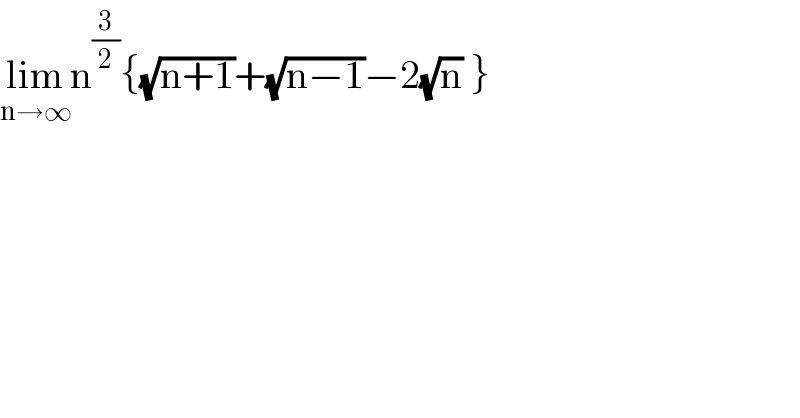
Question Number 95401 by john santu last updated on 25/May/20

$$\underset{\mathrm{n}\rightarrow\infty} {\mathrm{lim}n}^{\frac{\mathrm{3}}{\mathrm{2}}} \left\{\sqrt{\mathrm{n}+\mathrm{1}}+\sqrt{\mathrm{n}−\mathrm{1}}−\mathrm{2}\sqrt{\mathrm{n}}\:\right\}\: \\ $$
Answered by john santu last updated on 25/May/20

Commented by bobhans last updated on 25/May/20

$$\mathrm{great} \\ $$
Answered by abdomathmax last updated on 25/May/20

$$\mathrm{let}\:\mathrm{U}_{\mathrm{n}} =\mathrm{n}^{\frac{\mathrm{3}}{\mathrm{2}}} \left\{\sqrt{\mathrm{n}+\mathrm{1}}+\sqrt{\mathrm{n}−\mathrm{1}}−\mathrm{2}\sqrt{\mathrm{n}}\right\}\:\Rightarrow \\ $$$$\mathrm{U}_{\mathrm{n}} =\mathrm{n}^{\frac{\mathrm{3}}{\mathrm{2}}} \left\{\sqrt{\mathrm{n}}\sqrt{\mathrm{1}+\frac{\mathrm{1}}{\mathrm{n}}}+\sqrt{\mathrm{n}}\sqrt{\mathrm{1}−\frac{\mathrm{1}}{\mathrm{n}}}−\mathrm{2}\sqrt{\mathrm{n}}\right\}\:\mathrm{but} \\ $$$$\sqrt{\mathrm{1}+\frac{\mathrm{1}}{\mathrm{n}}}=\left(\mathrm{1}+\frac{\mathrm{1}}{\mathrm{n}}\right)^{\frac{\mathrm{1}}{\mathrm{2}}} \:\sim\mathrm{1}+\frac{\mathrm{1}}{\mathrm{2n}}\:+\frac{\frac{\mathrm{1}}{\mathrm{2}}\left(\frac{\mathrm{1}}{\mathrm{2}}−\mathrm{1}\right)}{\mathrm{2n}^{\mathrm{2}} } \\ $$$$=\mathrm{1}+\frac{\mathrm{1}}{\mathrm{2n}}−\frac{\mathrm{1}}{\mathrm{8n}^{\mathrm{2}} }\:\:\mathrm{and} \\ $$$$\sqrt{\mathrm{1}−\frac{\mathrm{1}}{\mathrm{n}}}=\mathrm{1}−\frac{\mathrm{1}}{\mathrm{2n}}−\frac{\mathrm{1}}{\mathrm{8n}^{\mathrm{2}} }\:\Rightarrow \\ $$$$\sqrt{\mathrm{n}+\mathrm{1}}+\sqrt{\mathrm{n}−\mathrm{1}}−\mathrm{2}\sqrt{\mathrm{n}}\sim\sqrt{\mathrm{n}}+\frac{\mathrm{1}}{\mathrm{2}\sqrt{\mathrm{n}}}−\frac{\sqrt{\mathrm{n}}}{\mathrm{8n}^{\mathrm{2}} } \\ $$$$+\sqrt{\mathrm{n}}−\frac{\mathrm{1}}{\mathrm{2}\sqrt{\mathrm{n}}}−\frac{\sqrt{\mathrm{n}}}{\mathrm{8n}^{\mathrm{2}} }\:−\mathrm{2}\sqrt{\mathrm{n}} \\ $$$$=−\frac{\sqrt{\mathrm{n}}}{\mathrm{4n}^{\mathrm{2}} }\:=−\frac{\mathrm{1}}{\mathrm{4}}\:\mathrm{n}^{\frac{\mathrm{1}}{\mathrm{2}}−\mathrm{2}} \:=−\frac{\mathrm{1}}{\mathrm{4}}\mathrm{n}^{−\frac{\mathrm{3}}{\mathrm{2}}} \:\Rightarrow \\ $$$$\mathrm{U}_{\mathrm{n}} \sim\mathrm{n}^{\frac{\mathrm{3}}{\mathrm{2}}} ×\left(−\frac{\mathrm{1}}{\mathrm{4}}\right)\mathrm{n}^{−\frac{\mathrm{3}}{\mathrm{2}}} \:\Rightarrow\mathrm{U}_{\mathrm{n}} \sim−\frac{\mathrm{1}}{\mathrm{4}}\:\Rightarrow \\ $$$$\mathrm{lim}_{\mathrm{n}\rightarrow+\infty} \:\mathrm{U}_{\mathrm{n}} =−\frac{\mathrm{1}}{\mathrm{4}} \\ $$$$ \\ $$
Commented by i jagooll last updated on 25/May/20

$$\mathrm{binomial}\:\mathrm{series}\:? \\ $$
Commented by abdomathmax last updated on 25/May/20

$$\mathrm{no}\:\mathrm{sir}\:\mathrm{developpement}\:\mathrm{of}\:\left(\mathrm{1}+\mathrm{x}\right)^{\alpha} \:\mathrm{at}\:\mathrm{integr}\:\mathrm{serie} \\ $$
